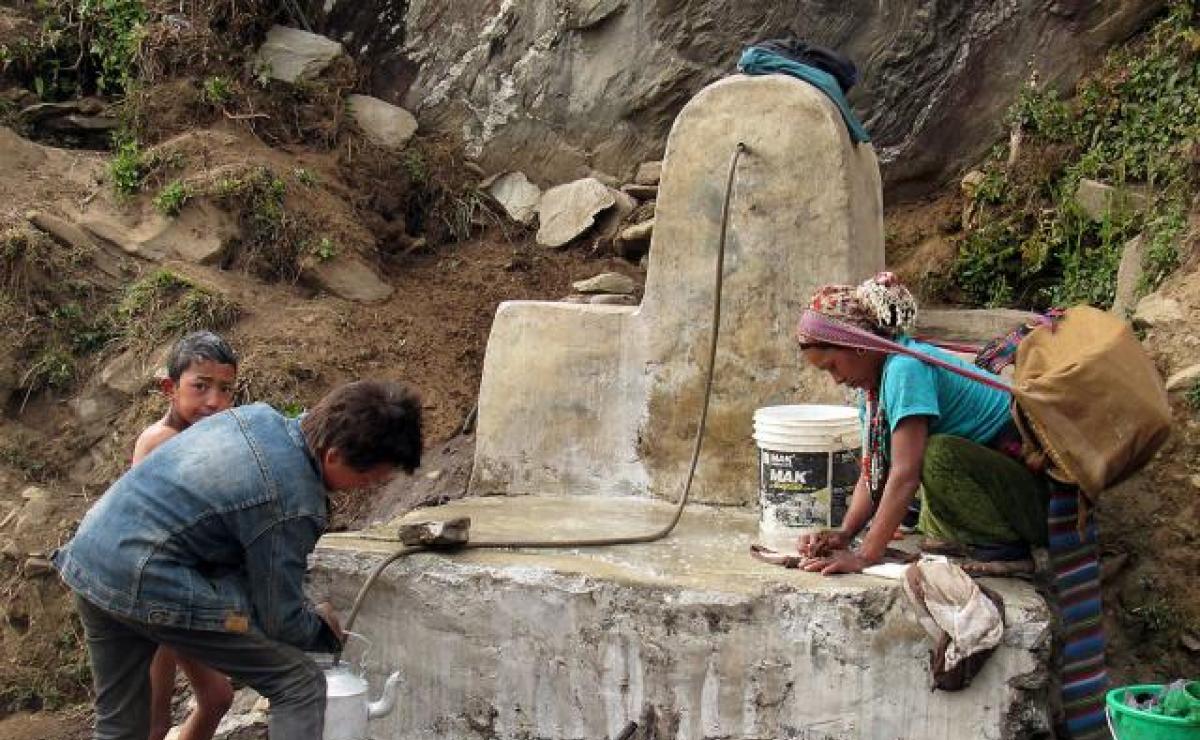Water after the earthquake

LWF repairs water supply systems in Nepal
(LWI) Less than a year ago, 48-year-old Gapalmo Thokra and her husband Thsering Fincho Thokra (50), residents of Thangdur village in Nepal’s Rasuwa district, had to spend up to four hours every morning fetching water. The earthquake in April 2015 caused a landslide which buried the tanks and pipelines of the existing water supply network. It took hours daily and several people to provide the 120 liters of water needed to cook for the family of five, and to quench the thirst of their three buffaloes, two oxen and five goats.
Like the Thokra family, all of the Thangdur households spent an average of six hours getting water every day following the earthquake.
A quarter of all water networks damaged
Today things are different in Thangdur. The village is one of many places where The Lutheran World Federation (LWF) Nepal, with a local partner organization, has rehabilitated the water supply. The project was led by the local community, Tshering Fincho Thokra was the chair of the Hugdung drinking water rehabilitation project. “LWF Nepal and the BATAS foundation provided the material,” he says. “They installed the water tank at the source, a reservoir tank, tap stand and pipelines. The locals contributed the masonry and the workforce.” Today, Thokra and his neighbors are fetching water in their vicinity.
Providing safe drinking water was one of the main issues following the magnitude 7.8 earthquake which shook Nepal in 2015. According to the Post Disaster Needs Assessment, conducted by the Nepali government, a quarter of the water supply networks in the 14 most affected districts were destroyed or damaged by the earthquake. The cost of repairing them, according to government estimates, could be around 1.8 billion USD which is a lot of money in a country where most people have less than a dollar a day to live.
LWF Nepal has been working to rehabilitate those networks in project areas in the Rasuwa, Sindhupalchowk, Dolakha, Lalitpur, Kathmandu and Kavre districts.
“With the repair of the water network, we have not only received clean drinking water but also a safe place to bathe”, says Parbati Ghimire from Baramchi. The people in her village were forced to use the water from irrigation canals for drinking and washing. As an immediate response to the situation, LWF and local partner Gramin Mahila Srijanashil Pariwar installeda new tap, reconstructed a storage tank and built a public bathing space.
More time to rebuild and study
In Pattitar village, Dolakha district, LWF also installed a water tap for the local school, which had completely collapsed during the earthquake, and was rebuilt in a different place. “I am grateful to LWF Nepal for installing a drinking water tap in the school," Sanman Bishwokarma, a local of Jiri Municipality, Dolakha says. The 50-year-old man had donated land for rebuilding the primary school.
The examples from all these places show how much difference a source of clean water makes. The installation of a tap in their community not only solved the need for drinking water. The local population can use the time which was spent before in fetching water for their livelihoods. Children, especially girls, have more time for school work. Also, as the Nepali government has now approved the new shelter models, many people in the community are glad about the extra time for the reconstruction of their new permanent houses.
“Earlier, my family used to spend around six hours’ time each day to fetch water. Now, we can use that time for farming, animal husbandry and political discussions,” says 37-year-old Bebi Thokra, a local politician who is campaigning as a candidate for the Nepali government in the upcoming elections.
Community engagement
LWF Nepal and its implementing partners have engaged the local communities on rehabilitation of water systems. The community was involved from the first steps of the planning stage and key in constructing the new water networks. Water user committees were formed to implement the water rehabilitation projects. The committees are responsible for procuring the materials required for the rehabilitation while LWF Nepal and partners provided the financial and technical support required for the construction.
“Working through users committees means local communities are taking the lead on implementation and decision making. Also, this practice promotes transparency and increases local ownership.” Dr. Prabin Manandhar, Country Director of LWF Nepal says.
In 2016 LWF has repaired and rehabilitated a total of 146 drinking water systems. 16 water schemes are currently under construction. Those systems are located in Rasuwa, Sindhupalchowk, Dolakha, Lalitpur, Kavre and Kathmandu districts. The majority of repaitered water networks are in Lalitpur and Sindhupalchowk districts.
In Sindhupalchowk, the district probably worst hit by the 2015 earthquake, LWF and partners have repaired a total of 47 water systems, making a difference for more than benefitting 12,700 people who no longer have to walk hours for clean water.
The Sustainable Development Goals, launched in 2015, include a target to ensure everyone has access to safe water by 2030, making water a key issue in the fight to eradicate extreme poverty.
Contribution by LWF/ U. Pokharel. Edited by LWF communications

